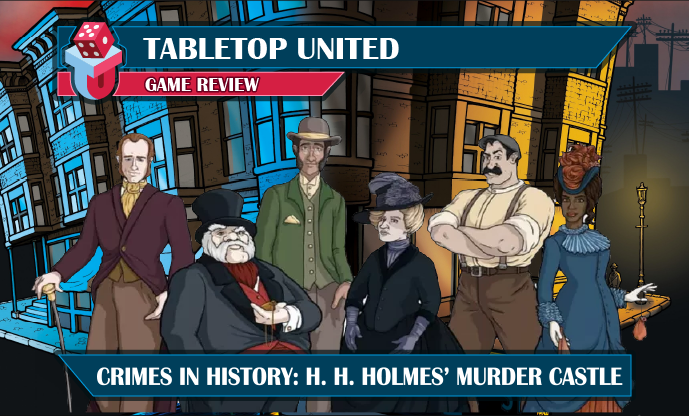
Designer: Brandt Hoffman & Seth A Cooper
Artist: Holly Carden
Publisher: Blueprint Gaming Concepts
Year Published: 2021
No. of Players: 1-7
Ages: 14+
Playing Time: 15-105 Minutes
Main Mechanic / Theme: Exploration & Action Drafting / Horror
Crimes in History: H. H. Holmes' Murder Castle does an excellent job at creating an atmosphere that is tense and, at times, a bit cold blooded!
Find more info on BoardGameGeek.com / Kickstarter
Overview:
Crimes in History: H. H. Holmes' Murder Castle is a tense and excited game of exploration and survival for 1 to 7 players as they make their way through the trap-filled corridors of the World's Fair Hotel, attempting to collect evidence and survive encounters with the murderous H. H. Holmes!
Gameplay and Mechanisms:
The following steps are taken as part of setting up Crimes in History: H. H. Holmes' Murder Castle:
Exploration Tiles – Select those tiles that match the game mode you will be playing (base game with or without 2nd Story expansion tiles as well as brick wall tiles). Starting tiles include 3 basement tiles and a pharmacy tile. These are arranged in a specific manner and represent the starting board state.
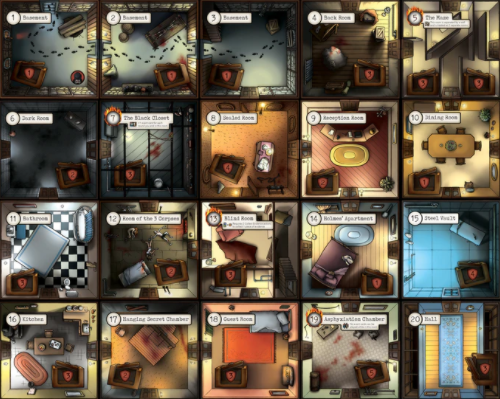
Action Tiles – Select those action tiles that match your player count.
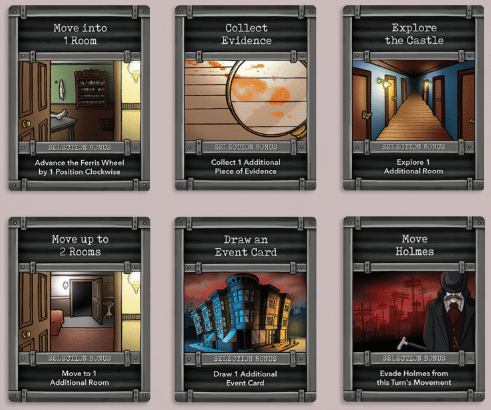
Character & Evidence Board - Select a character and matching evidence board. Each character provides a 1x use, unique ability which is indicated on the player board by a space on which a corresponding token will be placed. These unique abilities grant players additional exploration actions, the ability to construct obstacles as they move through the murder castle, copy event actions previously played, etc. In addition to their evidence boards, each player receives an evidence set-up card that tells that player how much of each evidence type they start with at the beginning of the game (e.g. 2 blue, 4 yellow, 3 green, 2 white, and 2 orange).
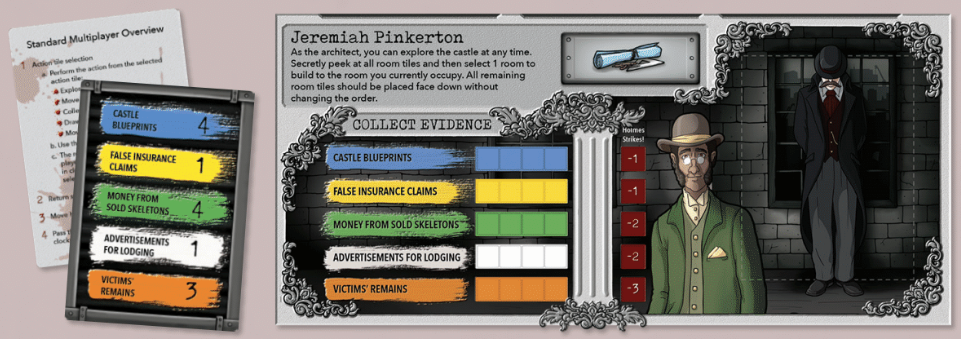
Evidence Cubes – Place all 5 evidence cube color sets (i.e. white, blue, yellow, green, and orange) into the evidence bag. Black cubes represent strikes delivered by Holmes. One evidence cube is drawn and placed in each safe located on the 3 basement tiles placed as part of setup.
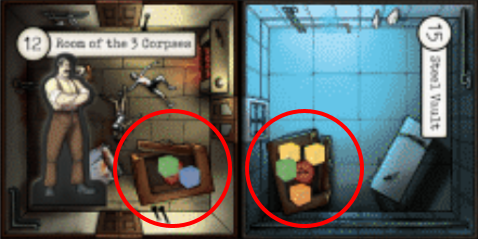
Ferris Wheel – Sets of 5 cubes are randomly drawn and placed in each of the 5 sections of the Ferris Wheel. Evidence cubes located in the bottom section of the wheel are available during gameplay when evidence can be transferred to the rooms that have been explored. Any time that the bottom section of the wheel has less than 5 cubes, the wheel is turned and new cubes are drawn to fill the wheel back up to 5.
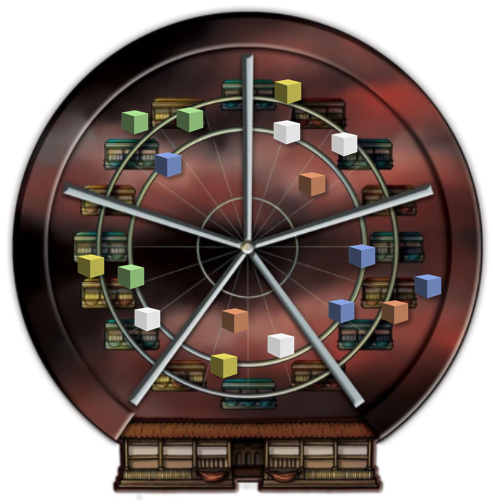
The following gameplay phases are carried out until the end game condition is met:
Action Drafting – In turn order, players draft one of the action tiles and immediately carry out the action as indicated (e.g., move into 1 room or up to 2 rooms, collect evidence, explore the castle, draw an event card, or move Holmes). This action selection mechanism provides all other players with the option to also utilize the action selected while providing the active player with a listed bonus which is often just an extra use of the original action (e.g., draw 1 more card, collect 1 more evidence, etc.). Players will each get to select 2 different actions each round, including:
- Exploring the Castle/Room – Players may draw additional room tiles, adding them to doorways printed on their current room tile. Once no additional tiles can be placed, this action tile is flipped to reveal the Explore the Room action side. This action is used to fill safes within rooms occupied by players with an evidence cube from the ferris wheel unloading zone.
- Moving – Players may move between adjacent rooms through unobstructed doorways. However, players cannot move into/through rooms where Holmes is located! Although most movement involves simply moving between adjacent rooms, the use of trapdoors/landing zones and hidden bookcase pathway tokens allows for players to slip through different parts of the castle more freely. You just have to discover these tokens first!
- Collecting Evidence – Retrieve an evidence cube (if present) from your current room.
- Draw an Event Card – Players may hold 3 event cards at a time. These events include those that provide effects that are immediate or upon play. These cards provide opportunities for player interaction, changes to the board state, etc.
- Move Holmes – The active player may move Holmes to an adjacent room, including those occupied by other guests. When present, players can play event cards they have saved to help avoid suffering a strike. If a player has no defense against Holmes, they suffer a strike (i.e. placing a black cube on their evidence board in the top empty space with a negative number). Suffering a Strike: When a negative number is covered, the suffering player must discard that number of evidence cubes from their player board.
Holmes Movement – After actions have been carried out, the top card of the Holmes movement deck is drawn. These cards instruct the 1st player to move Holmes to one of the rooms as indicated on the card. At times, no room matching those on the movement card has been explored yet; in this case, Holmes does not move (close call!). However, if Holmes is able to move into a room and it is occupied by 1 or more players, they will each suffer strikes as mentioned previously. Note: Players already in a room with Holmes prior to this phase will not suffer an additional strike. During this phase, multiple steps of movement can occur if a rampage card is drawn, resulting in 3 additional movement cards being drawn. In this way, multiple rampages can be triggered! This is bad news for guests!
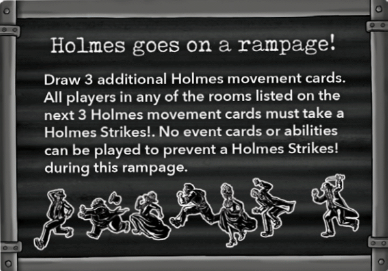
Additional Gameplay Features - As mentioned before, there are additional tokens (e.g., trapdoors/landing zones and hidden bookcase pathway) that can be utilized to increase movement options. There are also special rooms with unique rules that provide interesting choices when passing through those rooms.
2nd Story Expansion Content - The 2nd Story expansion offers a lot of great content, including a solo variant as well as a 1 vs. many mode in which you assume the role of Holmes! Additionally, this expansion offers new Holmes’ movement cards, and rooms to explore. My favorite addition it the laboratory in which potions are found. These facedown potions offer a bit of “push your luck” fun with some causing additional strike damage while others temporarily shield you from strike damage!
End Game Condition – The object of this game is quite simple: Be the first player to (a) collect sufficient evidence to fill your board and (b) race back to the pharmacy tile.
Theme
Although I was completely unfamiliar with the subject matter prior to playing this game, I think Crimes in History: H. H. Holmes' Murder Castledoes does an excellent job at creating an atmosphere that is tense and, at times, a bit cold blooded! As you frantically try to explore the castle, looking for evidence to satisfy your board requirements, you never quite know where Holmes will appear next. However, your fellow guests can be just as threatening at times, planting traps or playing cards that draw the attention of Holmes towards you (and away from them) in an effort to survive the night!
Production
Crimes in History: H. H. Holmes' Murder Castle has a nice overall production quality with chunky cardboard components and fairly detailed miniatures which just beg to be painted! the ferris wheel was a nice touch; however, I wish it had a bit more weight to it as the wheel didn't easily spin without a 2nd hand to anchor its base.
Final Thoughts:
As a sucker for tile flipping games, I loved the exploration element of Crimes in History: H. H. Holmes' Murder Castle. I would definitely like to have seen more unique rooms featuring their own rules/effects. I think those few that are featured in the base game and expansion really helped to make my experiencing with game enjoyable. The action drafting mechanism is one that I have seen in other games and while I really enjoy the fact that all players benefit from the actions selected by each player, I didn't always feel like there were many interesting choices, especially once the exploration tiles were exhausted. Once you've explored all you can, you are essentially moving about the castle, picking up cubes and hoping you don't lose any before the colors you need are uncovered in rooms. Based on these observations, I think the first 2/3 of the game are excellent while the last third feels a bit repetitive. With consideration for the global pandemic, I was not able to try the 1 vs. many mode but I do think this adds something interesting to the game that I'd like to explore down the road. All in all, this is a solid horror exploration game with simply mechanisms that make it easy to setup and teach!

